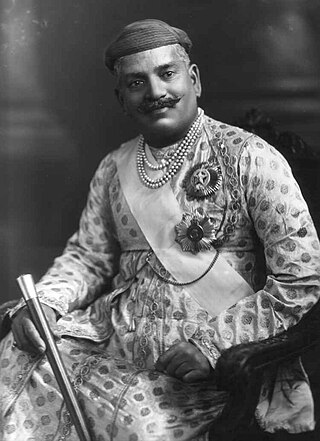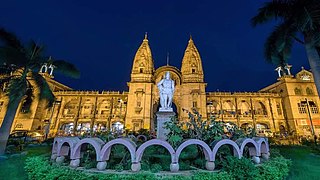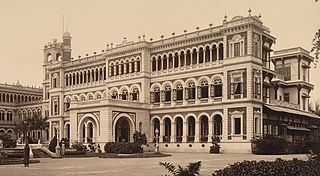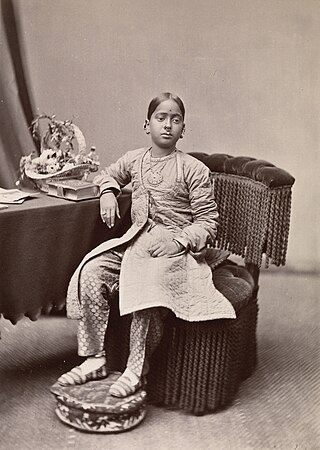
The Dawoodi Bohras are a religious denomination within the Ismā'īlī branch of Shia Islam. They number approximately one million worldwide and have settled in over 40 countries around the world. The majority of the Dawoodi Bohra community resides in India, with sizable congregations in Pakistan, Yemen, East Africa, and the Middle East. They also have a growing presence in Europe, North America, and Australia. The present leader is the 53rd al-Dai al-Mutlaq, Mufaddal Saifuddin who assumed office in January 2014.

Mohammed Burhanuddin was the 52nd Dā'ī al-Mutlaq of Dawoodi Bohras. He led the community for 49 years in a period of social, economic, and educational prosperity; strengthened and re-institutionalized the fundamental core of the community's faith; revived its culture, tradition, and heritage. In successfully achieving coexistence of traditional Islamic values and modern Western practices within the community, Burhanuddin completed the work his predecessor Taher Saifuddin had started. Burhanuddin was presented the highest national civilian honors of the states of Egypt and Jordan recognising his revivalism and restoration efforts. He was known in Arab countries as Azamat us-Sultan. Owing to extensive travels for community reach-out, he was the first Dā'ī al-Mutlaq to visit Europe, Australia, and America.

Mehsana, also spelled Mahesana, is a city and the headquarters of Mehsana district in the Indian state of Gujarat. Established in 14th century, the city was under Gaekwads of Baroda State from 18th century to the independence of India in 1947. Dairy, oil and natural gas are major industries in the city.

Taher Saifuddin, also known as Tahir Sayf al-Din, was the 51st and longest serving Da'i al-Mutlaq of the Dawoodi Bohras. Saifuddin adapted the modernisation in Western and European ideas, and established its benefits for the Bohras, whilst still steeped in the traditions and the culture of the community's Fatimid heritage. Saifuddin laid substantial groundwork in terms of philanthropy, education, entrepreneurship, social outreach, political outreach, and community upliftment upon which his successors, Mohammed Burhanuddin and Mufaddal Saifuddin, continued to build, resulting in an unprecedented era of prosperity among the Dawoodi Bohras.

Sayajirao Gaekwad III was the Maharaja of Baroda State from 1875 to 1939, and is remembered for reforming much of his state during his rule. He belonged to the royal Gaekwad dynasty of the Marathas which ruled parts of present-day Gujarat.

Siddhpur, also spelled Sidhpur, is a town, municipality and headquarter of Sidhpur taluka in Patan district, in the Indian state of Gujarat. It is a historical place located on the bank of the endorheic Saraswati River, which is probably a remaining of the ancient Sarasvati River.

Ahmad Shah I, born Ahmad Khan, was a ruler of the Muzaffarid dynasty, who reigned over the Gujarat Sultanate from 1411 until his death in 1442. He was the grandson of Sultan Muzaffar Shah, founder of the dynasty.
Sayaji Baug is a garden located in Vadodara, Gujarat, India. it was built by Maharaja Sayajirao Gaekwad - a great visionary ruler of Baroda. It is the biggest garden in Western India with the area surrounding more than 100 acres (40 ha).

Baroda Medical College is a medical educational institution for undergraduate and postgraduate medical studies that comes under the Faculty of Medicine of the Maharaja Sayajirao University of Baroda. It is located in the Raopura area at Vadodara, India. It is primarily affiliated with Sir Sayajirao General Hospital. The college was established in 1949.

The Nyay Mandir, lit. 'Temple of Justice', is a court building in Vadodara in the state of Gujarat, western India.

The Baroda Museum & Picture Gallery is an archeological and natural history museum in Vadodara, Gujarat, India. It was built in 1894 on the lines of the Victoria & Albert Museum and the Science Museum of London.

Khanderao market is a palatial commercial building located on Chamaraja Road in Vadodara, Gujarat, in western India. It was erected by Maharaja Sayajirao Gaekwad III in 1906–07 as a gift to the city municipality to mark the silver jubilee of his administration. The offices of the Vadodara Municipal Corporation are located here.

Makarpura Palace is a royal palace of Gaekwads of the Baroda State, in present-day Vadodara, Gujarat, India. It was built by Maharaja Khende Rao in 1870, in the Italian style. It was used as summer residence and hunting resort by the Royal Family. The palace is now used as a training school called No.17 Tetra School by the Indian Air Force.
The term Gujarati Muslim is usually used to signify an Indian Muslim from the state of Gujarat in western coast of India. Most Gujarati Muslims have the Gujarati language as their mother tongue, but some communities have Urdu as their mother tongue. The majority of Gujarati Muslims are Sunni, with a minority of Shi'ite groups.

The Alavi Bohras are a Tayyibi Musta'lavi Isma'ili Shi'i Muslim community from Gujarat, India. In India, during the time of the 18th Fatimid Imam Al-Mustansir Billah around 1093 AD in Egypt, the designated learned people (wulaat) who were sent from Yemen by missionaries (du'aat) under the guidance of the imam established a da'wah in Khambhat.

Baroda State was a kingdom within the Maratha Confederacy and later a princely state in present-day Gujarat. It was ruled by the Gaekwad dynasty from its formation in 1721 until its accession to the newly formed Dominion of India in 1949. With the city of Baroda (Vadodara) as its capital, its relations with the British Raj authorities were managed by the Baroda Residency. The revenue of the state in 1901 was Rs. 13,661,000. Baroda formally acceded to the Dominion of India on 1 May 1949, before which an interim government was formed in the state.

Maharani Chimnabai II was a queen and the second wife Maharaja Sayajirao Gaekwad of the princely state of Baroda, Gujarat, British India. She is the author of the treatise The position of Women in Indian Life (1911), and was the first president of the All India Women's Conference (AIWC) in 1927-1928, as well as the president of the National Council of Women in India in 1928-1937.

Syedna Dr. Mufaddal Saifuddin (T.U.S.) is the spiritual leader, the 53rd Da'i al-Mutlaq of one million Dawoodi Bohras, a subgroup of the Tayyibi, Mustaali, Ismaili Shia branch of Islam. He is the second son of the 52nd Da'i al-Mutlaq, Mohammed Burhanuddin, whom he succeeded in 2014. He is the Chancellor of Aligarh Muslim University and Jamia Miliya Islamia University situated in India. He has led a number of cultural, social, and economic initiatives. In Islamic Cairo, he rebuilt shrines of the Ahl al-Bayt and led the restoration of medieval Fatimid architecture, notably Al-Anwar Mosque, Al-Aqmar Mosque, Al-Juyushi Mosque, and Lulua Mosque. In Yemen, he has spearheaded several campaigns to improve socio-economic conditions of the inhabitants of the Haraaz region, introducing sustainable agricultural systems, improving local infrastructure and providing equal access to education for children.

The Chimnabai Clock Tower, also known as the Raopura Tower, is a clock tower situated in the Raopura area of Vadodara, Gujarat, India. It was completed in 1896 and named in memory of Chimnabai I (1864–1885), a queen and the first wife of Sayajirao Gaekwad III of Baroda State. It was built in Indo-Saracenic architecture style.

Maharani Chimnabai I was a queen and the first wife of Maharaja Sayajirao Gaekwad III of the princely state of Baroda, British India. Several memorials were built by Sayajirao following her early death.



















